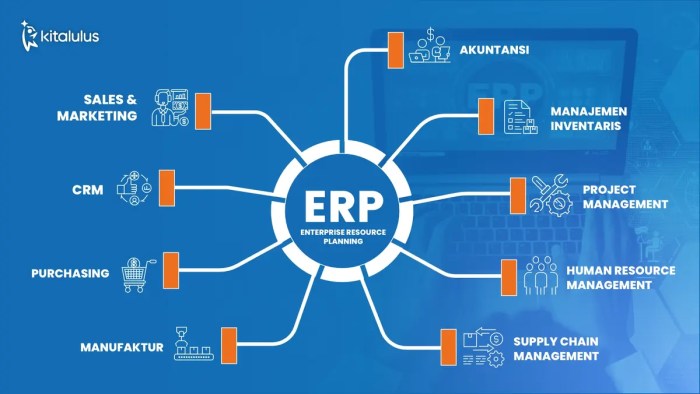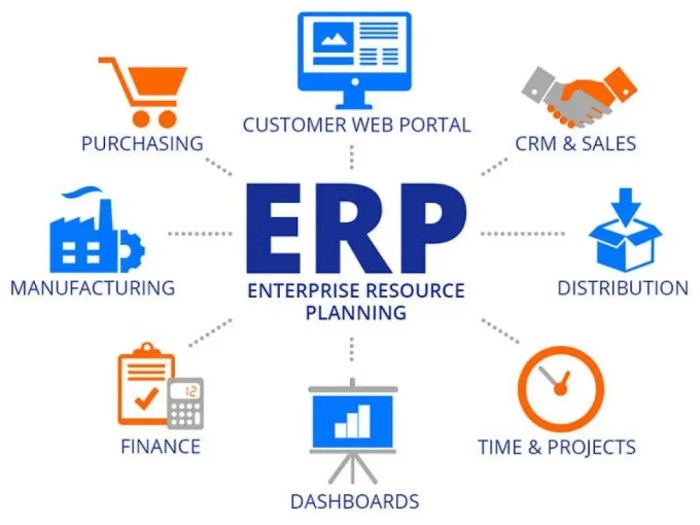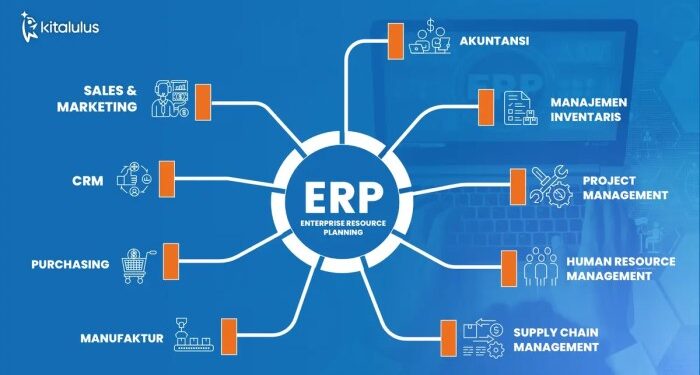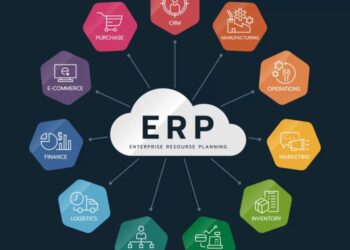Embark on a journey into the realm of ERP E, where businesses harness the potential of this software to revolutionize their operations. This guide is designed to offer a deep dive into the world of ERP E, providing insights and examples that showcase its impact and benefits.
From defining ERP E to exploring its key features and implementation strategies, this guide will equip you with the knowledge needed to make informed decisions about integrating ERP E into your business processes.
Definition and Overview of ERP E

ERP E stands for Enterprise Resource Planning for E-commerce, a software solution designed to integrate and manage various aspects of a business's operations in the e-commerce sector. It plays a crucial role in streamlining processes, enhancing efficiency, and improving overall productivity.
Basic Functions and Features of ERP E Software
ERP E software typically includes modules for inventory management, order processing, customer relationship management, financial management, and supply chain management. These features allow businesses to automate tasks, track performance metrics, and make informed decisions based on real-time data.
Examples of Industries or Sectors Using ERP E
- E-commerce: Online retailers utilize ERP E software to manage inventory, process orders, and provide a seamless shopping experience for customers.
- Manufacturing: Companies in the manufacturing sector leverage ERP E systems to optimize production processes, track resources, and improve supply chain efficiency.
- Logistics and Distribution: ERP E solutions help logistics and distribution companies coordinate shipments, manage warehouses, and ensure timely delivery of goods.
- Wholesale and Distribution: Wholesalers and distributors use ERP E software to streamline procurement, inventory management, and sales processes.
Benefits of Implementing ERP E
Implementing ERP E can provide numerous benefits for companies looking to streamline their operations and enhance efficiency. By integrating ERP E into their workflow, organizations can experience improved communication, better decision-making, and increased productivity.
Improved Efficiency
- ERP E systems centralize data and processes, eliminating the need for manual data entry and reducing the risk of errors.
- Automation of repetitive tasks frees up employees to focus on more strategic activities, boosting overall efficiency.
- Real-time data access allows for faster decision-making and better resource allocation.
Enhanced Communication
- ERP E promotes collaboration across departments by providing a centralized platform for sharing information and insights.
- Employees can access real-time data from any location, facilitating remote work and improving communication flow.
- Streamlined communication leads to quicker problem-solving and more effective decision-making processes.
Cost Savings
- By reducing manual processes and streamlining operations, ERP E can help companies save on labor costs and minimize errors.
- Improved inventory management and forecasting capabilities can lead to reduced inventory holding costs and better inventory turnover.
- Optimized resource allocation and enhanced visibility into financial data can result in significant cost savings over time.
Real-World Examples
- Amazon: The retail giant implemented ERP E to streamline its supply chain management, leading to faster delivery times and improved customer satisfaction.
- Microsoft: By integrating ERP E into its operations, Microsoft improved data accuracy, reduced operational costs, and enhanced decision-making processes.
- Procter & Gamble: The consumer goods company utilized ERP E to optimize its production processes, resulting in increased efficiency and reduced waste.
Key Features and Modules of ERP E
ERP E software comes with a wide range of features and modules designed to streamline business processes and improve overall efficiency. Let's dive into the essential components and functionalities of ERP E systems.
Key Features of ERP E
- Integrated System: ERP E offers a centralized platform that integrates various functions like finance, human resources, supply chain management, and more.
- Real-time Data: Users can access up-to-date information and analytics to make informed decisions quickly.
- Customization: ERP E systems can be customized to meet the specific needs of different industries and businesses.
- Scalability: The software can scale with the growth of the organization, accommodating increased data and user requirements.
- Automation: ERP E automates repetitive tasks, reducing manual errors and improving productivity.
Modules of ERP E Systems
- Finance Module: Manages financial transactions, budgeting, forecasting, and reporting.
- Human Resources Module: Handles employee data, payroll, benefits administration, and performance management.
- Inventory Management Module: Tracks inventory levels, orders, and supply chain operations.
- Customer Relationship Management (CRM) Module: Manages customer interactions, sales, marketing, and customer support.
- Supply Chain Management Module: Optimizes the flow of goods and services from suppliers to customers.
Comparison of Popular ERP E Solutions
| ERP E Solution | Key Features |
|---|---|
| Oracle NetSuite |
|
| SAP Business One |
|
| Microsoft Dynamics 365 |
|
Implementation and Integration of ERP E

Implementing an ERP E system within an organization involves several key steps to ensure a successful integration process. Companies may face various challenges during this implementation phase, but with proper planning and strategies, these challenges can be overcome. Here are some tips for a successful ERP E implementation process:
Steps Involved in Implementing an ERP E System
- Conduct a thorough analysis of the organization's current processes and requirements to determine the scope of the ERP E system.
- Select a suitable ERP E solution that aligns with the organization's needs and goals.
- Develop a detailed implementation plan outlining timelines, tasks, responsibilities, and milestones.
- Customize the ERP E system to fit the organization's specific business processes and workflows.
- Train employees on how to use the new ERP E system effectively and provide ongoing support.
- Test the system thoroughly to ensure it meets the organization's requirements and resolves any issues before full deployment.
- Roll out the ERP E system in phases to minimize disruption to operations and allow for adjustments based on feedback.
Challenges During Integration of ERP E
- Resistance to change from employees accustomed to existing processes.
- Data migration issues when transferring information from legacy systems to the new ERP E system.
- Lack of top management support and involvement in the implementation process.
- Integration complexities with other existing systems and technologies within the organization.
- Budget constraints and unexpected costs that may arise during implementation.
Tips for a Successful ERP E Implementation Process
- Engage key stakeholders early on in the process to gain buy-in and support for the ERP E implementation.
- Communicate clearly with employees about the reasons for implementing the new system and how it will benefit the organization.
- Allocate sufficient time and resources for training and change management to ensure a smooth transition to the new ERP E system.
- Regularly review and assess the progress of the implementation to address any issues or roadblocks promptly.
- Work closely with the ERP E vendor or implementation partner to leverage their expertise and best practices.
Customization and Scalability of ERP E

Customizing ERP E software is crucial to ensure that it aligns with the specific needs and requirements of a business. Every organization operates differently, with unique processes, workflows, and data management systems. By customizing the ERP E software, companies can streamline their operations, enhance efficiency, and improve overall productivity.
Importance of Customization
ERP E systems offer a wide range of customization options that allow businesses to tailor the software to their specific needs. This includes customizing workflows, data fields, reports, dashboards, and user interfaces. For example, a manufacturing company may need to customize the ERP E software to track production processes, manage inventory, and monitor supply chain activities effectively.
By customizing the software, the company can optimize its operations and achieve better results.
Scalability of ERP E
One of the key advantages of ERP E systems is their scalability. As a company grows or undergoes changes, the ERP E software can easily scale to accommodate the increased workload and complexity. Whether it's expanding into new markets, adding more users, or integrating new modules, ERP E systems can adapt to meet the evolving needs of the business.
This scalability ensures that the software remains relevant and effective in supporting the company's growth and development.
Customizable Features
ERP E systems offer a variety of customizable features that cater to diverse business requirements. Some common customizable features include:
- Customizable dashboards and reports to provide real-time insights and analysis.
- Customized workflows to streamline business processes and improve efficiency.
- Flexible data fields and modules that can be tailored to specific industry requirements.
- Personalized user interfaces that enhance user experience and usability.
By leveraging these customizable features, businesses can optimize their ERP E software to meet their unique needs and achieve their strategic objectives effectively.
Outcome Summary
In conclusion, ERP E emerges as a pivotal tool for modern businesses seeking to optimize their workflows and drive growth. By understanding the nuances of ERP E and its customization options, companies can pave the way for enhanced efficiency and scalability in a dynamic market landscape.
Popular Questions
What does ERP E stand for?
ERP E stands for Enterprise Resource Planning for E-commerce.
How can ERP E streamline processes?
ERP E streamlines processes by centralizing data, automating tasks, and providing real-time insights for decision-making.
What are some challenges in ERP E integration?
Challenges in ERP E integration may include data migration issues, resistance from employees, and the need for extensive training.
Why is customization important in ERP E?
Customization in ERP E ensures that the software aligns with specific business requirements, optimizing its effectiveness.
How can ERP E systems scale with business growth?
ERP E systems can scale with business growth by offering modules that can be added or expanded to accommodate increasing needs and complexities.








![Best Construction ERP Software [2024 Edition]](https://health.bandungnews.id/wp-content/uploads/2025/10/Top-10-Best-Construction-ERP-Software-to-Use-in-2024-1-120x86.jpg)



